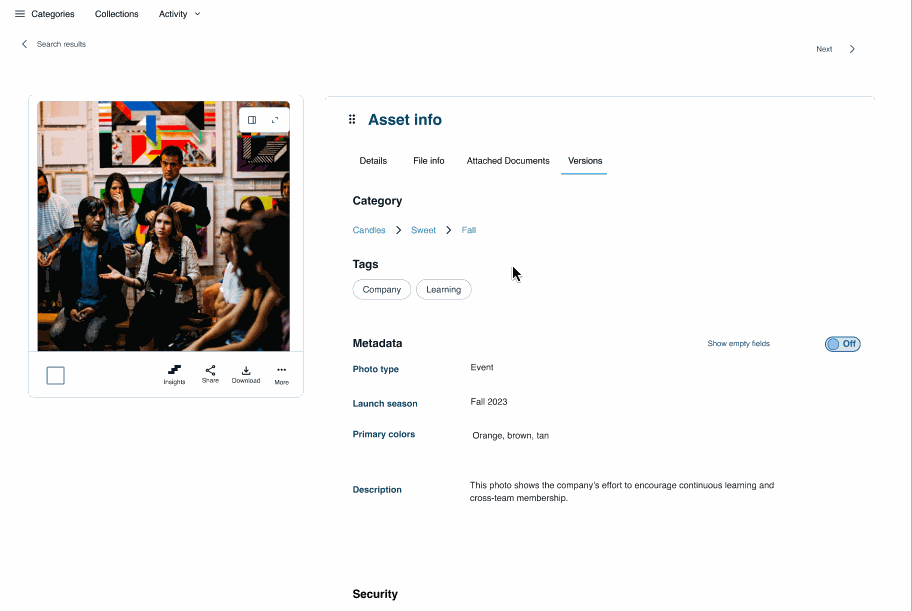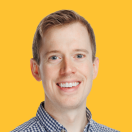What You Need To Know About DAM and AI

Collection :
Artificial intelligence (AI) is changing the way we create content. It’s also reshaping how it’s managed, accessed, and analyzed.
In this post, we explore the role of AI in digital asset management (DAM). Including, how to manage AI generated media, using AI tooling with DAM platforms for more efficient processes, and tips for operationalizing AI at your organization.
Tips for managing AI-generated content
As you know, content creation is no longer a strictly human endeavor. Generative AI tools like ChatGPT and DALL-E are gaining popularity and making it easier for organizations to outsource content creation to AI technologies. But there’s a catch: When content creation changes, so must the way we manage it.
Keep legal sensitivities in mind
AI is opening up new complexities and ambiguities to navigate with copyright and intellectual property (IP) laws. Do you need to credit AI alongside human creators? Are you responsible when AI plagiarizes copyrighted content? How does AI impact image rights and licensing? We answer questions like these in a guest CMSWire article, but our point is that the legalities around AI-generated content are complicated. When using AI, make sure you know the laws, proceed with caution, and involve a legal professional in content approval and guideline creation — which leads us to our next point.
Update your brand guidelines
Brand guidelines support brand consistency and define a framework for how people can and cannot use your visual, verbal, and written assets. With the widespread use of AI and its evolving legal parameters, organizations must reexamine their brand guidelines and clearly define if, when, how, by whom, and in what capacity AI-generated content is approved and appropriate for use.
Create new metadata fields
When leveraging AI-generated content in a DAM system, you need to create new metadata fields to ensure you can uphold your brand guidelines, mitigate legal risks, analyze performance, properly credit AI and content creators, troubleshoot issues, and more.
Examples of AI-inspired metadata fields:
- Generated by: There are dozens of generative AI tools. Did DALL-E, ChatGPT, Gemini, Midjourney, or another AI tool produce the asset? This can be part of the file metadata and mapped to a field within the DAM.
- Prompt: What text prompt was used to generate an asset? This will help others recreate similar content following the prompts that work well and fit a desired brand style.
- Series number: If you enter the same prompt more than once, AI tools will produce a unique asset each time. Therefore, you need an identifier to differentiate assets that came from the exact same prompt.
- Fact-checked (Y/N): AI isn’t always accurate. It can plagiarize, invent information, and pose other legal risks. Implementing the right checks and balances will protect your organization.
- Contributors: Who wrote the prompt? Who created text, designs, photos, or other content that AI used to create an asset? You may need to give these people credit or use this information during an audit.
Analyze and track
Just like with any content, you need to know if your AI-generated assets are delivering results and engaging customers in positive ways. And if you’re using AI to increase the volume and velocity of content produced, then it’s even more important to be able to quickly analyze performance at scale, as well as have automated systems in place to help manage what content remains in use or is pulled from circulation.
Using AI in DAM technology
AI’s integration into DAM isn’t just about managing assets created by these tools; it’s also about leveraging AI within the DAM system itself. Let’s look at some ways AI is transforming DAMs from simple storage solutions into intelligent content hubs.
Multiple Ways to Integrate AI in DAM
Native AI Functionality: Out-of-the-box AI features in modern DAM solutions that are already embedded directly in the tool and ready to use.
Pre-Built Plugins: Vendors offer plugins powered by AI, allowing easy integration of tools with some flexibility. Custom prompts can guide the AI to use controlled vocabularies, existing metadata associated with a file, or target keywords to improve relevance to your business.
Custom Integrations: Work with in-house teams or external developers to link AI tools such as GPT models or custom-trained algorithms to your DAM for full control.
Standalone AI Tools: Tools that function independently can still be used alongside your DAM solution to enhance specific workflows without complete integration.
Common and Future Trends of AI in DAM
AI enhances DAM systems in the following areas by automating high-volume tasks and offering deeper insights:
- Tag and Keyword Generation: Automatically tag assets (vs. manual tagging) based on their features and content.

- Captions and Descriptions: Natural language processing (NLP) automatically generates asset descriptions for easy understanding and retrieval. Can be used for image alt text to support accessibility and SEO requirements.
- Text Extraction: Extract text from image-based files like ads or product packaging to make it searchable.
- Translation: Translate metadata, transcriptions, and other text into multiple languages to support multiple regions.
- Video Transcription: Generate transcripts using speech-to-text from video content for accessibility and searchability.
- Color Filtering and Search: Sort and retrieve images based on dominant colors.
- Semantic Search: Enable searches based on meaning rather than exact keywords for more intuitive browsing.
- Facial Recognition: Identify individuals in photos or videos for improved cataloging.

- Duplicate Detection: Prevent asset clutter by identifying and removing duplicates.
- Content Summarization: Summarize long documents for quicker evaluations.
- Insight Retrieval: Extract actionable patterns from asset-related data.
Operationalizing AI in Your Organization
To truly harness AI within DAM, you’ll need a structured approach. Follow these steps to introduce and optimize AI in your enterprise content workflows.
Identify Top Pain Points
Begin by pinpointing where your current systems fall short. Is it in asset searchability, recurring tasks like tagging, content generation and personalization, or usage and performance insights? Identifying bottlenecks—whether in search and discovery, streamlining repetitive tasks, or gaining user insights—will help prioritize AI solutions that deliver tangible value.
Audit Your Asset Management
Evaluate how your organization currently manages and uses digital assets by considering key factors such as desired outcomes, metadata (descriptive, administrative, structural), users and access, and existing configurations and capabilities. Identify any gaps in these areas and explore how AI can address them. This analysis will provide a solid baseline for tracking improvements.
Plot and Prioritize
Toggling on an out-of-the box video transcription feature is going to be much less effort than training a custom model to recognize your product photography. Using a 2x2 framework to visualize the value against effort for each AI use case and capability can help your teams discuss and prioritize your AI roadmap.
When applied to plotting value against effort for AI use cases and capabilities, the x-axis of the grid represents the “effort” required (such as time, cost, or complexity to implement), while the y-axis represents the “value” generated (such as efficiency gains, cost savings, or strategic impact). Each AI use case or capability is plotted as a point within one of the four quadrants, enabling teams to categorize and prioritize opportunities. Here’s how the quadrants typically break down:
Low Value, High Effort These represent low-impact projects that demand considerable resources. They are typically avoided or deprioritized unless they address indirect benefits or compliance requirements. | High Value, High Effort These are longer-term, high-impact initiatives that require significant resources but have the potential to deliver substantial results. These projects should be carefully planned and incorporated into the roadmap. |
|---|---|
Low Value, Low Effort These are low-priority tasks that can be addressed if resources and time allow but aren’t critical to the overall strategy. | High Value, Low Effort These are the “quick wins” where AI solutions can deliver significant impact with minimal investment. Teams should prioritize these first to demonstrate early success and build momentum. |
By using a 2x2 framework, teams can visually compare and discuss multiple AI options, gaining a clear understanding of where to focus their efforts. This approach fosters alignment across stakeholders, helps identify opportunities with the best return on investment, and ensures resources are allocated effectively in building an AI roadmap.
Set Quality Control Criteria
Ensure that AI outputs meet your brand and quality standards by evaluating them for accuracy and precision. Consider:
Accuracy: How well must AI correctly identify the contents and context of the asset?
Precision: How well must AI generate metadata that is…?
Factual
Relevant
Plausible as search terms that DAM users may enter
Determine how you'll keep a human in the loop to assess the AI outputs and make adjustments.
Apply a Continuous Improvement Framework
Adopting a new and rapidly evolving technology like AI requires continuous improvement. Use a framework like Plan-Do-Study-Adjust (PDSA) where AI tools are periodically evaluated, tweaked, and re-optimized to adapt to changing business needs.
Regular updates are essential for AI systems to stay efficient and effective in managing digital assets.
Use the Plan-Do-Study-Adjust (PDSA) framework for continuous improvement.
- Plan: Implement initial AI solutions aligned with business goals.
- Do: Deploy and integrate the AI tools into your workflow.
- Study: Regularly evaluate the performance of AI tools to ensure they deliver value and improve efficiency.
- Adjust: Use insights from evaluations to refine and optimize the AI tools.
Regularly evaluate and refine AI tools to ensure they drive actionable improvements, stay aligned with your business needs, and adapt to market trends, maximizing their utility and impact. By following these practices, you can enhance digital asset management while achieving greater success in marketing and content creation.
Experiment With Custom Prompts
You don’t need to have it integrated with your DAM system to start taking advantage of its capabilities. Here are just a few ways you can use it effectively:
- Need a head start on your integration strategy? Use a prompt to develop a plan for prioritizing your next three integrations for maximum impact. When I tried this, it even generated some code!
- Looking for taxonomy advice? Ask for recommendations—do you really need all those fields, or could some be consolidated?
- Some of our customers create monthly DAM user newsletters to keep their teams informed about new content, features, and tips. Provide a few key points, and let it craft the email for you.
- Need help analyzing data for your assets? Ask it to guide you through the process.
- Want to solidify your DAM’s business case or ROI? Leverage it to think like a CEO or finance expert and build a compelling argument.
With just a few prompts, you can achieve faster, more efficient results in countless ways—saving you time and effort while driving impact.
Ready to get the most out of AI for DAM?
AI has the potential to forever change the way you create and manage your content. Knowing how to harness its power to automate time-consuming tasks, streamline your workflows, and improve the effectiveness of your content efforts is a determining factor in the success of your DAM practices. Make no mistake — AI has arrived. Are you getting the most out of it?
To learn more about AI for DAM or to see Acquia DAM’s AI capabilities in action, schedule a live demo today.



